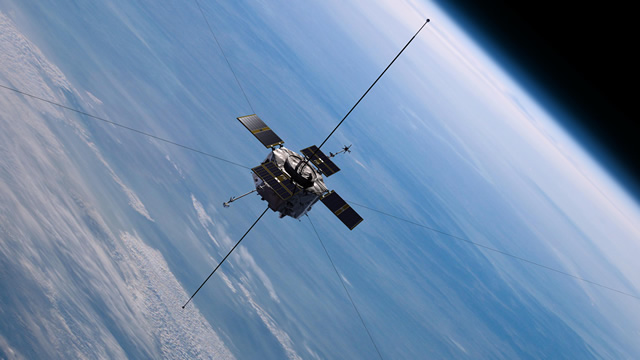November 1, 2012
Media Contact:
Geoff Brown
(240) 228-5618
Geoffrey.Brown@jhuapl.edu
RBSP Completes Commissioning Phase
Twin NASA spacecraft begin primary two-year operations phase to unlock the mysteries of Earth’s radiation belts

Artist rendering of one of the Radiation Belt Storm Probes with its solar panels and booms fully deployed. Credit: NASA/JHUAPL
On Oct. 28, NASA’s twin Radiation Belt Storm Probes (RBSP) completed their 60-day commissioning phase, and began their two-year primary science mission to explore our planet’s radiation belts, named for their discoverer, James Van Allen.
The commissioning phase, which began just after RBSP’s launch on Aug. 30 from Cape Canaveral Air Force Station, is a standard period during which spacecraft systems are deployed and certified, and instruments are powered up and readied for normal science gathering operations. Each RBSP spacecraft carries an identical set of five instrument suites that will allow scientists to gather data on the charged particles, fields and waves of the Van Allen radiation belts with unprecedented detail. Earth’s radiation belts can respond in unexpected ways, often quite suddenly and dramatically swelling and shrinking in response to dynamic changes in the sun.
“We are very pleased to have the RBSP spacecraft successfully complete the commissioning period,” said Kim Cooper, newly named RBSP Project Manager at the Johns Hopkins University Applied Physics Laboratory (APL), which built the spacecraft and will manage the mission for NASA from its Laurel, Md., campus. “Over the past 60 days, the many complex systems on the probes have come to life and started to work together. Progress has been rapid; RBSP’s science instrument teams are already recording some illuminating data, and scientists are taking advantage of their best understanding of the mechanics and properties of the radiation belts to date.”
In 1958, the team led by University of Iowa professor (and former APL staffer) James A. Van Allen, using observations from Explorer 1 (the first American satellite), made the surprising discovery that intense radiation – highly-energized charged particles that can damage spacecraft and harm astronauts – is trapped by our planet’s magnetic field. Later space missions revealed that the radiation occurs in two swaths around Earth. The inner, relatively stable belt, composed mainly of protons, extends from the top of the atmosphere out to an altitude of some 4,000 miles. The outer belt, composed mainly of high-energy, fast moving electrons, extends from about 8,000 miles to more than 26,000 miles above Earth’s surface.
To explore these hazardous regions of space, the two sun-pointing RBSP spacecraft will fly in nearly identical eccentric orbits that cover the entire radiation belt region. The spacecraft orbits will reach maximum altitudes between 18,672 mi. and 19,417 mi., and minimum altitudes between 311 mi. and 419 mi.
Learn more about RBSP’s instrument suites by visiting here and in the RBSP press kit (PDF), available here.
RBSP is part of NASA's Living With a Star Program to explore aspects of the connected sun-Earth system that directly affect life and society. LWS is managed by the agency's Goddard Space Flight Center in Greenbelt, Md. APL built the RBSP spacecraft and manages the mission for NASA.

